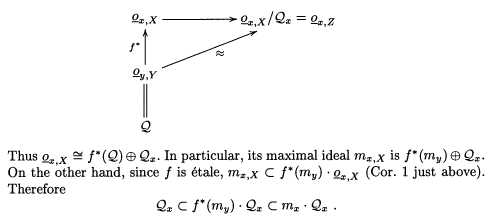I am a student whose major interest is not algebraic geometry, but for various reasons I began to re-read Mumford's Red Book, and I found myself stuck in a quite simple theorem. Since I had studied some algebraic geometry before, (based on my remaining intuitions) this theorem seems very simple, but I am having trouble understanding the last part of the proof. The theorem is as follows:
(Theorem 2, page 177) Let $\mathcal O$ be a complete local ring, with maximal ideal $\mathfrak m$, residue field $k$. Let $f:X\rightarrow Y = \mathrm {Spec} (\mathcal O )$, $x\mapsto y = [\mathfrak m ]$. Assume $k=\kappa (y) \simeq \kappa (x)$. Then $f$ etale near $x$ $\Rightarrow $ $f$ a local isomorphism near $x$.
In this book, Mumford first defines etale morphisms non-intrinsically: he first defines that the morphism $X=\mathrm {Spec} R[x_1 , \cdots , x_n ] / (f_1 , \cdots , f_n ) \rightarrow \mathrm {Spec} R$ induced by the inclusion is etale at a point $x\in X$ when the Jacobian of $f_1 , \cdots , f_n $ does not vanish at $x$.
Using this definition, he reduces this theorem to the following situation: $$X=\mathrm {Spec} \mathcal O [x_1 , \cdots , x_n ] / (f_1 , \cdots , f_n )$$ $$ x=\mathrm m + (x_1 -a_1 , \cdots , x_n - a_n )$$ $$\mathrm {det} (\partial f_i / \partial x_j )(x)\neq 0,$$ where $a_1 , \cdots , a_n \in \mathcal O$. Then by Hensel's lemma, he finds elements $\alpha _1 , \cdots , \alpha _n \in \mathcal O$ such that $$Z=\mathrm {Spec} \mathcal O [x_1 , \cdots , x_n ] / (x_1 -\alpha _1 , \cdots , x_n -\alpha _n )$$ is a subscheme of $X$ through $x$, which is clearly isomorphic to $Y$. Now he tries to prove that $X=Z$ near $x$, by first defining $\mathcal Q$ to be the $\mathcal O _X $-ideal defining $Z$ and then as follows, which I cannot understand:
If this is shown, then the rest is clear from Nakayama's lemma.
I think that I am missing something fundamental and this might be a stupid question, but from the start, I can't see why $\mathcal O_{y,Y}=\mathcal Q$. Can someone please explain this thoroughly?
This might be an unappropriate question for mathoverflow; if so, I will migrate this down to MSE.

